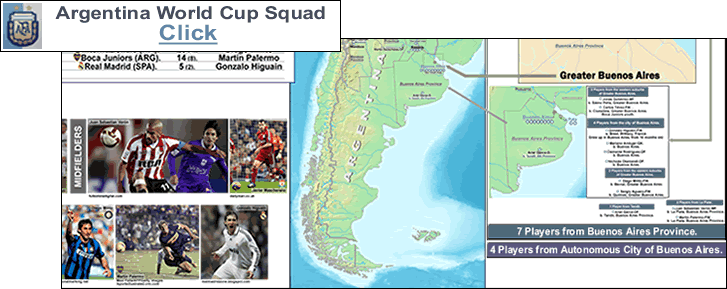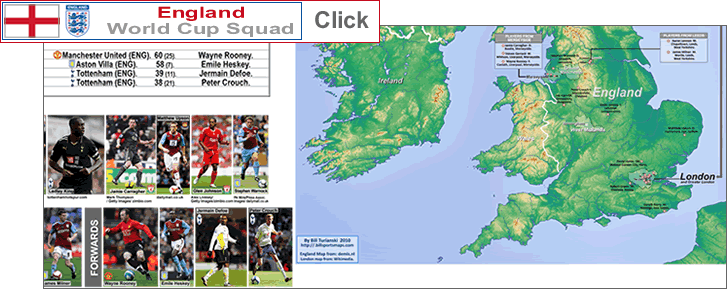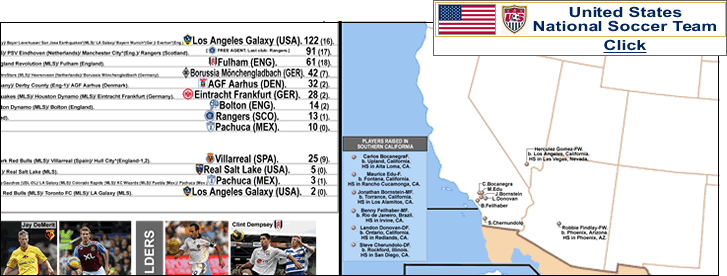
Argentina 2010 World Cup squad.
The map shows the birthplaces and/or the hometowns of the 23-man Argentina team that competed in the 2010 FIFA World Cup in South Africa. At the bottom, left on the map page are photos of all the players in the Argentina squad who saw action in their 5 matches in the competition (20 player photos, in the gear of their professional clubs). International appearances (aka caps) and international goals are listed in the chart section, and are up to date as of 3rd July, 2010.
-
The map page is a bit complicated, with separate sections for inset maps of two of the three largest cities in Argentina, Buenos Aires and Rosario, Santa Fe Province. Córdoba is the second largest city in Argentina, slightly larger than Rosario, but Córdoba has a far smaller influence than Rosario in footballing terms. For starters, there has been no first division club from Córdoba for three years now, and no Córdoba club has ever won the title. Meanwhile, Rosario boasts 9 Argentine titles…5 by Newell’s Old Boys and 4 by Rosario Central (and there is a third Santa Fe Province-based club in the top flight, Colón, from the city of Santa Fe, 130 km. north of Rosario).
…
Sprawling Buenos Aires has a metropolitan area population of around 12.9 million {2002 estimate}.
Rosario has a metropolitan area population of around 1.2 million {2001 census}), and is 270 kilometers (160 miles) NW of Buenos Aires.
…
The Buenos Aires section, on the far right of the map page, has a large map of Greater Buenos Aires that includes the city of La Plata, which is the capital city of Buenos Aires Province and is 59 km. (36 mi.) SE of the city of Buenos Aires. The Autonomous City of Buenos Aires is a separate entity in both legal and political terms, and is not part of Buenos Aires Province. [It's status is similar to that of Washington, DC (aka the District of Columbia), in the United States.] The Autonomous City of Buenos Aires, or Distrito Federal, is shown on the main map and the inset maps in a dark purple color.
…
15 of the current 20 first division clubs in the Argentine Primera División are located in the area comprising Greater Buenos Aires and neighboring La Plata. The breakdown is… 6 clubs from the Autonomous City of Buenos Aires (the current champions Argentinos Juniors, Boca Juniors, Huracán, River Plate, San Lorenzo, and Vélez Sarsfield); 1 club from the suburbs west of the City of Buenos Aires (Tigre); 6 clubs from the suburbs east of the City of Buenos Aires (Arsenal di Sarandi, Banfield, Independiente, Lanús, the just-promoted Quilmes, and Racing Club); and 2 clubs from La Plata (Estudianties and Gimnasia La Plata).
…
The city of La Plata has a population of around 690,000 {2001 census}. As mentioned, La Plata is home to 2 first division Argentine clubs…Estudiantes de La Plata, who are reigning Copa Libertadores champions and 4-time Argentine champions; and perennially relegation-threatened Gimnasia y Esgrima La Plata. The Argentina World Cup roster features two La Plata-born players, Juan Sebastián Verón (who captains Estudiantes) and Martín Palermo, the 36-year old Boca Juniors striker who had a 10 year exile from the national team before being recalled by Argentina coach Diego Maradona, in South American World Cup qualifiers in 2009. Palermo famously scored the 93rd minute winning goal versus Peru in October 2009, which kept Argentina from being eliminated from World Cup qualification.
…
8 players on the Argentina squad were born and/or grew up in Greater Buenos Aires, or Gran Buenos Aires…
Two players came from the western suburbs (Zona Oeste), striker Carlos Tévez and defensive midfielder Jonás Gutiérrez. Both these players play in England professionally, Tévez with Manchester City, and Gutiérrez with Newcastle United.
Four players on the squad came from the City of Buenos Aires. 3 were born and raised there: subs Mariano Andújar (goalkeeper for Catania of Italy) and Clemente Rodríguez (defender for Estudiantes), and projected starter Nicholás Otamendi, the young central defender who was instrumental in Vélez Sarsfield winning the 2009 Clausura title, and who was sold yesterday [Monday, June 7] to AC Milan.
The other City of Buenos Aires-raised player on the national squad is Real Madrid goal machine Gonzalo Higuaín, who was born in Brest, France (where his father played professionally), but moved with his family back to Argentina when he was 10 months old.
There are two players on the squad who were born in the southern suburbs of Greater Buenos Aires (Zona Sur), in the Quilmes partido: forwards Sergio Agüero (of Atlético Madrid), and Diego Milito (of Internazionale). Milito scored both goals in Inter’s UEFA Champions League victory over Bayern Munich in late May. Both these players are expected to see action in South Africa [note: who knows what the starting lineup will look like, because Diego Maradona's selections have defied conventional wisdom, if not basic logic, to say the least].
…
There are 10 players on the 23-man World Cup roster who were born and/or grew up in Greater Buenos Aires/La Plata. There is one more player from Buenos Aires Province, defender Ariel Garcé, who plays for Colón and is from Tandil, which is in south central Buenos Aires Province 360 kilometers (220 miles) SSW of the city of Buenos Aires. [There is one top flight club from southern Buenos Aires Province, the just-promoted Olimpo, from Bahía Blanca, which is 569 km. (353 miles) south of Buenos Aires.]
-
The Rosario inset map section is in the grey rectangle at the top of the map page, and includes an outline map of it’s province, Santa Fe. Five players were born in Santa Fe Province, three in Rosario, including the planet’s best football player, Lionel Messi. Messi moved with his family to Barcelona, Spain, when he was 13 years old. Lionel Messi suffered from a rare hormonal problem that could only be alleviated by very expensive injections of a growth hormone… at a price (of around $900 per month) that his original club, Newell’s Old Boys, balked at paying. So when FC Barcelona offered to pay for the injections, the Messi family moved to Barcelona, and Lionel Messi became part of the FC Barcelona set-up, where he remains to this day. Messi has never returned to visit his first club, Newell’s Old Boys, and the Newell’s top brass claim they intended on continuing to pay for Messi’s injections (but receipts prove otherwise).
…
The other two Rosario-born players on the squad are Maxi Rodríguez and Ángel Di María. Rodríguez is an attacking midfielder who now plays for Liverpool, and who scored a spectacular winning goal from a left-footed-volley in the 98th minute of Argentina’s 2006 World Cup second round match versus Mexico. Ángel Di María is a talented young playmaker who is expected to start in midfield, and plays for Portuguese giants Benfica.
…
The other two players who come from Santa Fe Province are both slated to start for Argentina in South Africa: captain and defensive midfielder Javier Mascherano (also of Liverpool), and Internazionale defender Walter Samuel.
-
In total, 6 of the 23 Argentine provinces, plus the Distrito Federal, (or City of Buenos Aires) produced players on the 2010 World Cup squad. Besides the 11 players from the Buenos Aires City-and-Province, and the 5 players from Santa Fe Province, there are 4 more provinces that produced players on the squad…Córdoba Province, Entre Rios Province, Mendoza Province, and Misiones Province. To give you an idea of how little of a part these provinces play in the Argentine football scene, there is only one current first division club from these four provinces, and that is Godoy Cruz of Mendoza (who actually fared surprisingly well last campaign, finishing in third).
…
Córdoba Province produced 4 players, while one player each came from the provinces of Entre Rios (Marseille defender Gabriel Heinze), Mendoza (Colón goalkeeper Diego Pozo), and Misiones (AZ Alkmaar goalkeeper Sergio Romero, who is slated to start in South Africa).
Córdoba and Enter Rios provinces, along with Santa Fe Province, form the economic region known the Center Region.
Mendoza Province is in an arid region in the far west of Argentina at the foothills of the Andes Mountains and is closer to Santiago, Chile than Buenos Aires.
Misiones Province is a jungle-filled panhandle surrounded by Paraguay and Brazil, and is the site of the world’s largest waterfall by volume, at Iguazu Falls.
Córdoba Province features the aforementioned city of Córdoba (1.5 million population {2008 estimate}), and just north of that is the salt lake known as Mar Chiquita, where two squad players came from (Bolatti and Burdisso). The four Córdoba Province-born players all play professionally in Europe…Bayern Munich defender Martín Demichelis (a projected starter), and three who play in Italy: AS Roma defender Nicholás Burdisso, Palermo midfield wizard Javier Pastore, and Fiorentina midfielder Mario Bolatti. The last two, Pastore and Bolatti, both made their mark leading the medium-sized club Huracán to the brink of the 2009 Apertura title (they lost it to Vélez Sarsfield on the final day).
Thanks to the contributors to the pages at en.wikipedia.org, Argentina national football team.
Thanks to Fans Edge.com, for the photos of the Argentina jerseys.
Thanks to Zimbio.com, for several of the player photos.
Thanks to Demis of the Netherlands, for the Argentina and Rosario base maps, Demis Web Map Server.
Thanks to Sam Kelly, at Hasta El Gol Siempre site, for fact-checking and proof-reading, and for information on players.


